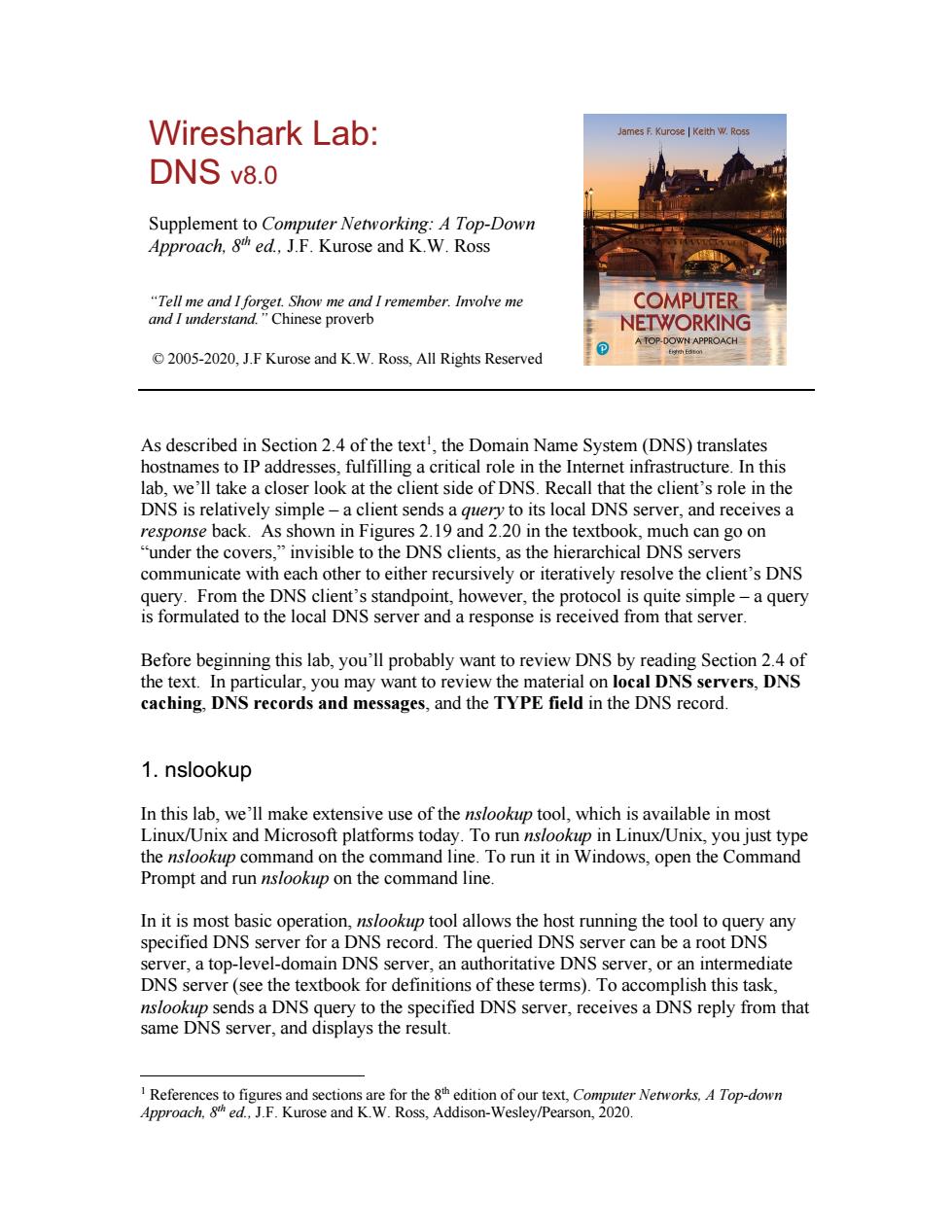正在加载图片...

Wireshark Labi DNS v8.0 Supplement to Cor uter Networking:A Top-Down Kurose and KW.Ross COMPUTER NETWORKING 2005-2020.J.F Kurose and K.W.Ross.All Rights Reserved As described in Section 2.4 of the text',the Domain Name System(DNS)translates hostnames to IP addresses,fulfilling a critical role in the Internet infrastructure.In this lab,we'll take a closer look at the client side of DNS.Recall that the client's role in the DNS is relatively simple-a client sends a query to its local DNS server,and receives a response back.As shown in Figures 2.19 and 2.20 in the textbook,much can go on "under the covers,"invisible to the DNS clients,as the hierarchical DNS servers communicate with each other to either recursively or iteratively resolve the client's DNS query.From the DNS client's standpoint,however,the protocol is quite simple-a query is formulated to the local DNS server and a response is received from that server. Before beginning this lab you'll probably want to review dns by reading section 2 4 of the text.In particular,you may vant to review the material on local DNS servers.DNS caching.DNS records and messages,and the TYPE field in the DNS record 1.nslookup In this lab,we'll make extensive use of the nslookup tool,which is available in most Linux/Unix and Microsoft platforms today.To run nslookup in Linux/Unix,you just type the nslookup command on the command line.To run it in Windows,open the Command Prompt and run nslookup on the command line. t5cogabPmo高sbgereo3n server.a top-level-domain DNS server,an authoritative DNS server,or an intermediate DNS server (see the textbook for definitions of these terms).To accomplish this task. a DNS me DNS cified DNS server,receives a DNS reply from that and the ultWireshark Lab: DNS v8.0 Supplement to Computer Networking: A Top-Down Approach, 8th ed., J.F. Kurose and K.W. Ross “Tell me and I forget. Show me and I remember. Involve me and I understand.” Chinese proverb © 2005-2020, J.F Kurose and K.W. Ross, All Rights Reserved As described in Section 2.4 of the text1 , the Domain Name System (DNS) translates hostnames to IP addresses, fulfilling a critical role in the Internet infrastructure. In this lab, we’ll take a closer look at the client side of DNS. Recall that the client’s role in the DNS is relatively simple – a client sends a query to its local DNS server, and receives a response back. As shown in Figures 2.19 and 2.20 in the textbook, much can go on “under the covers,” invisible to the DNS clients, as the hierarchical DNS servers communicate with each other to either recursively or iteratively resolve the client’s DNS query. From the DNS client’s standpoint, however, the protocol is quite simple – a query is formulated to the local DNS server and a response is received from that server. Before beginning this lab, you’ll probably want to review DNS by reading Section 2.4 of the text. In particular, you may want to review the material on local DNS servers, DNS caching, DNS records and messages, and the TYPE field in the DNS record. 1. nslookup In this lab, we’ll make extensive use of the nslookup tool, which is available in most Linux/Unix and Microsoft platforms today. To run nslookup in Linux/Unix, you just type the nslookup command on the command line. To run it in Windows, open the Command Prompt and run nslookup on the command line. In it is most basic operation, nslookup tool allows the host running the tool to query any specified DNS server for a DNS record. The queried DNS server can be a root DNS server, a top-level-domain DNS server, an authoritative DNS server, or an intermediate DNS server (see the textbook for definitions of these terms). To accomplish this task, nslookup sends a DNS query to the specified DNS server, receives a DNS reply from that same DNS server, and displays the result. 1 References to figures and sections are for the 8th edition of our text, Computer Networks, A Top-down Approach, 8th ed., J.F. Kurose and K.W. Ross, Addison-Wesley/Pearson, 2020